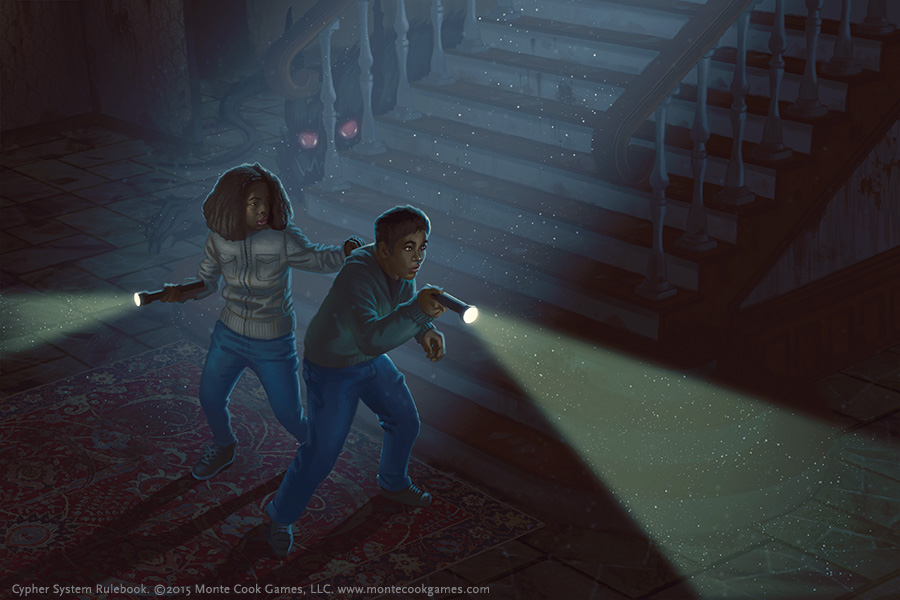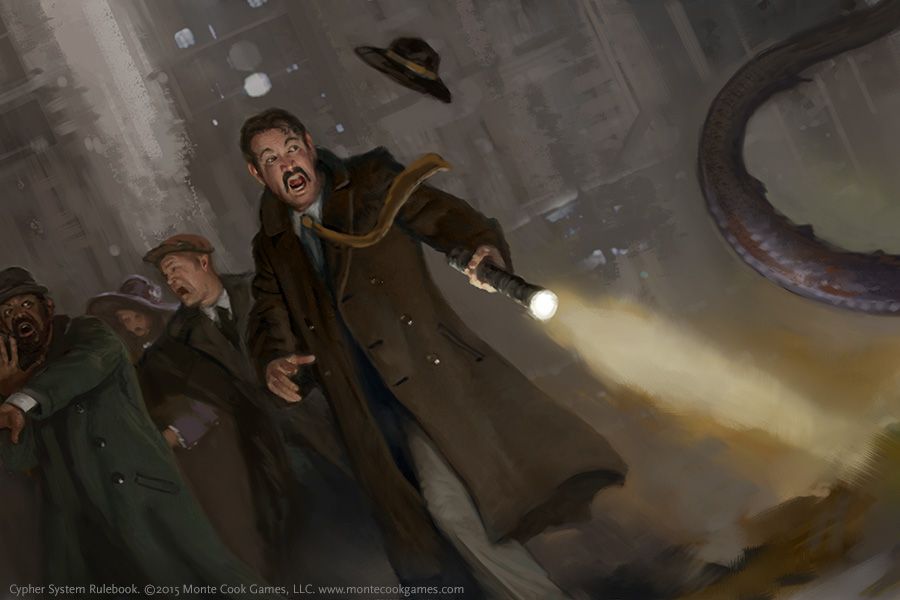Horror has been a part of RPGs since the early days—certainly since the initial release of Call of Cthulhu back in 1981. I love the tension horror injects into an RPG, and most of my campaigns over the past 20 years or so have at least an element of it. I’m currently running a hard sci-fi survival Cypher System campaign that’s just introduced the PCs to the horror element that’s going to be a factor in the adventures to come.
All that said, RPGs don’t naturally do horror well. Unease? Sure. Tension? When done right. But actual fear—that cold feeling down in your gut? That need to look away when the detective investigates the attic in The Grudge? The hesitation to turn the page the first time you read Pet Cemetery? When was the last time you really experienced that in an RPG?
A novelist or filmmaker gets to control the pace in a way a gaming group just can’t. Fiction reveals what it wants at the author’s whim, and a film immerses the audience across a range of senses. Those are advantages RPGs don’t share. But that doesn’t mean you can’t generate fear—it’s just a bit more of a challenge, and you have to know what tricks will make it work in an RPG.
What strikes fear into a player? Only one thing: the unknown. Players aren’t scared by monsters, no matter how creepy you make them sound. They aren’t afraid of the dark, and they aren’t scared by spooky sound effects or mood lighting.

So the way to generate a fear response is to pit them against the unknown. It’s not enough to face a creature they haven’t seen before: They have to realize they don’t know the outcome of the situation. They don’t know how it’s going to unfold. They don’t know what might happen next, or even which of their cherished assumptions about their characters or the game world are, in fact, true.
Here’s an example: About ten years or so ago I played in a Call of Cthulhu campaign that ran for well over a year. In the course of our investigations, we were occasionally visited by the ghost of a creepy old man. These sightings were never long; sometimes he said something brief, but mostly he just leered at us for a moment before vanishing. Could he harm us—or even affect us? We didn’t know. And we didn’t know what he wanted, but he seemed to have a mysterious purpose. As the campaign progressed, we found ourselves deliberately avoiding the crossroads where he was most often encountered. Eventually it became clear that we’d have to confront him (he wasn’t the boss monster, but he was important to the campaign’s climactic events). The very thought of it put a pit in every stomach. There was more than one shaky hand reaching for the dice as we finally headed into that encounter.

So how do you make that sort of thing happen? Here are some specific tips:
- Remember that fear happens in the narrative, not the action scene. The fight is the resolution of the horror, not the horror itself. In that last example, we were most scared as we headed into the confrontation with the ghost, not when we actually faced him.
- Set things up. In one campaign I ran, the heroes once rode into an abandoned town, noticing a ghoulish figure watching them as they drove in. They spent the next several sessions worrying about what they had seen before they eventually faced the ghouls. This was similar to the ghost of the old man in the previous example, who literally haunted us through nearly a year of play. The game TORG did this in a setting-wide manner with the realm of Orrorsh: They hinted at this realm of horror since the launch of the game, giving only brief glimpses, so that by the time they published a sourcebook and invited gamers to head into it my party, at least, was terrified by the prospect.
- As part of setting things up, make it the norm to mix up the challenge levels in your game. If the players can assume you’ll only throw encounters at them that they can defeat, well, they’ll assume that’s true of the unknown antagonists as well as the known. So make it an assumption of the game that sometimes one must flee or be killed. (Then see my point about commitment, below.)
- Reskin creatures. In my example above, I had scoured the net to find some really haunting artwork to show the players when they first saw the ghoulish creature. They couldn’t pigeonhole it as something from a game book, and the image played upon their imagination. Stat-wise, the creatures weren’t that exotic, but by the time the players actually encountered them that didn’t matter.
- Put unknowns in the environment. I once played a rogue in a dungeon crawl run by Monte. (This was back in the Third Edition days.) Exploring just ahead of the party, I found the passageway walls, floor, and ceiling increasingly covered in spiders. Not monstrous spiders. Not, apparently, even dangerous spiders. But their presence seemed to mean something, and I found myself quite hesitant to continue on.
- Push players outside their comfort zones. You can do this in the game, by putting them in situations where their usual strengths won’t help them. (But use this sparingly; one of the great satisfactions of RPG gaming is playing to your strengths, and if you really undermine your players’ confidence in their characters the game won’t be fun.)
- In a related technique, force players to commit to a course of action before they fully understand what they’re committing to. Once players know (or even think they know) what they’re facing, the tension is gone. But if they have to make irrevocable decisions about how to move forward when it’s clear they don’t know what they’re facing, they start to sweat a bit.
- Isolate players from trusted resources. This is really just a variant on pushing them out of their comfort zones. Separate them from their friends—or even, sparingly, each other. Neutralize (temporarily) their favorite artifacts or abilities. (GM intrusions are great for this sort of thing.) That forces them to find new ways to solve problems, and the uncertainty over whether the new ways will work adds to the sense of the unknown.
- Accrue negatives. The granddaddy of this philosophy is Call of Cthulhu’s sanity system. In the Cypher System, Horror Mode does the same sort of thing. As the story proceeds, the situation becomes subtly (usually) worse for the PCs.
- And finally: Set the mood. Dim the lights a bit and play some quiet, spooky music. This is often the first technique cited for injecting horror into the game, but it really only helps if all those other pieces are in place. Atmosphere absolutely cannot bring horror to your game, but it can help settle the players into the right mindset and counter the distractions that might undermine your fine efforts.
These are just some of the best methods that have worked for me; I’m sure there are others. If you have more ideas, drop by the MCG Facebook page and post them there!